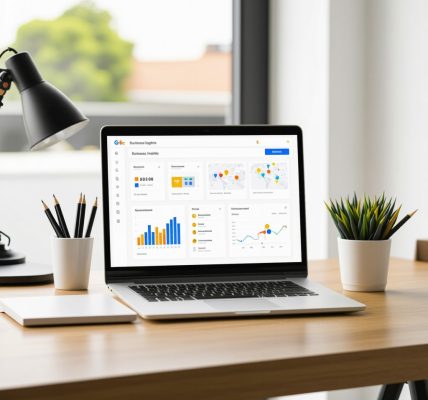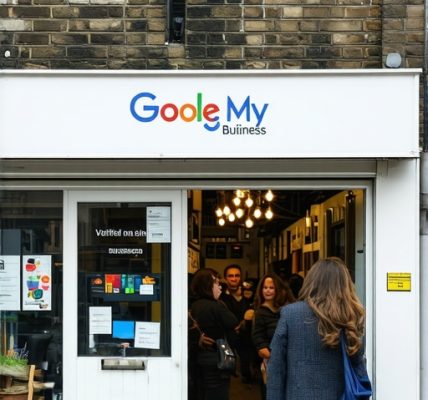Unlocking the Hidden Power of ‘Near Me’ in Google Business Profiles
In the evolving landscape of local search, optimizing your Google Business Profile (GBP) for ‘Near Me’ queries is no longer optional—it’s essential. Consumers increasingly rely on proximity-based searches to find products and services instantly, making local visibility a crucial competitive edge. But how does one truly harness the potential of Google’s ‘Near Me’ search behavior to drive targeted traffic and tangible growth? This guide dives deep into advanced, actionable strategies backed by expert insights and real-world application.
Crafting Location Signals That Speak Google’s Local Language
Google’s local algorithm thrives on precise, consistent, and layered location data. Beyond merely listing your address, ensure your GBP includes hyperlocal descriptors such as neighborhood names, landmarks, or service areas. Embedding these terms naturally within your business description, services, and even posts can enhance relevance for ‘Near Me’ searches. For example, a bakery in Chicago’s Lincoln Park district should emphasize this locale in their profile to capture nearby foot traffic effectively.
Elevate Engagement with Rich, Geo-Targeted Content
Regularly publishing Google Posts that highlight time-sensitive offers, events, or customer stories localized to your vicinity can significantly boost engagement metrics. These dynamic signals inform Google that your business is active and relevant to current local demand. Moreover, incorporating keywords synonymous with ‘near me’ such as ‘close by,’ ‘local,’ or ‘in your neighborhood’ within posts and Q&A sections can subtly reinforce your geographic relevance.
What Are the Key Technical Tweaks to Enhance ‘Near Me’ Visibility?
Addressing the Nuances of Google’s Local Search Algorithm
Technical optimization is often overlooked but critical. Start by verifying your GBP is accurately categorized with primary and secondary categories that match your services. Leverage Google’s service area feature if you serve multiple locations without a storefront, specifying exact radii or zip codes. Consistent NAP (Name, Address, Phone) citations across all web directories reduce confusion and improve trust signals. Additionally, optimizing images with geo-tagged metadata and descriptive filenames can subtly influence local ranking factors.
Harnessing Customer Reviews as Local Trust Anchors
Encouraging customers to leave detailed reviews that mention location-specific experiences can dramatically enhance your profile’s authority for ‘Near Me’ searches. Responding professionally and promptly to these reviews not only builds trust but also signals active management—a factor Google rewards. For proven tactics on review generation and management, explore expert review strategies.
Integrate Citation Management for Consistent Local Signals
Maintaining uniform business information across trusted citation platforms is integral to local SEO success. Discrepancies in your business name, address, or phone number can dilute your local relevance. Leveraging professional citation services ensures your GBP’s information is authoritative and consistent, elevating your chances in ‘Near Me’ queries. Learn more about citation management services that deliver measurable ranking improvements.
Engage with Us: Share Your Experience or Questions on Optimizing for ‘Near Me’
Have you implemented any unique strategies for boosting your Google Business Profile’s ‘Near Me’ visibility? Share your experiences or ask questions in the comments below to foster a community of local SEO excellence. For a comprehensive dive into optimizing your profile effectively, check out our detailed guide here.
For further research, the Google Places API documentation offers authoritative insights into how Google interprets and serves local business data, reinforcing the importance of precise and comprehensive profile optimization.
Leveraging User Behavior Insights to Refine ‘Near Me’ Optimization
Understanding how users engage with ‘Near Me’ queries can unlock nuanced opportunities to tailor your Google Business Profile. Search intent often varies—some users seek immediate availability, while others prioritize quality or specific services nearby. Incorporating behavior-driven keywords such as “open now,” “24/7 near me,” or “best rated nearby” into your GBP content and posts can capture diverse intent layers and improve click-through rates.
Leveraging Local Schema Markup for Enhanced Search Context
Implementing local business schema markup on your website complements your GBP by providing structured data that helps search engines understand your business details comprehensively. Schema elements like address, geo-coordinates, opening hours, and service areas reinforce your local relevance, especially for ‘Near Me’ queries. This technical enhancement can positively influence how your business appears in rich snippets and map results, boosting visibility and user engagement.
How Can Integrating Hyperlocal Content Elevate Your ‘Near Me’ Search Rankings?
Hyperlocal content refers to information tailored to very specific geographic locations, such as neighborhoods or small communities. Embedding blog posts, FAQs, or service pages that address local events, landmarks, or customer testimonials can deepen your connection with the community and signal to Google your authentic presence in that area. For instance, a plumbing service writing about “pipe repairs in downtown Brooklyn” creates targeted relevance that resonates with nearby searchers.
Studies by Moz, a leader in SEO research, highlight that businesses integrating hyperlocal keywords and localized content experience significantly higher engagement and local pack rankings. This underscores the strategic value of content that goes beyond generic location mentions to embrace community-specific narratives.
Optimizing Google Posts Timing and Frequency for Maximum Impact
Posting consistently but strategically on your GBP can influence local search performance. Analyze peak activity periods in your area—such as weekends for retail stores or weekday mornings for service providers—and schedule posts accordingly. Frequency matters too; bi-weekly updates maintain momentum without overwhelming your audience. Use posts to highlight limited-time offers, local partnerships, or community involvement, reinforcing your active status and local relevance.
Advanced Review Management: Encouraging Location-Specific Feedback
Requesting reviews that mention specific locations or experiences related to your service areas strengthens your GBP’s local signals. For example, a café might encourage patrons to mention the nearby park or landmark they visited with their coffee. Additionally, leveraging review response templates that acknowledge these local references can enhance user trust and engagement. These tactics amplify your presence in ‘Near Me’ searches and foster a loyal customer base.
For more insights on review strategy and customer engagement, visit our comprehensive guide on GMB review generation best practices.
Monitoring and Adapting to Google’s Local Algorithm Updates
Google frequently updates its local search algorithms, affecting how ‘Near Me’ queries are processed and ranked. Staying informed through trusted SEO news sources and leveraging tools that track local ranking fluctuations enables timely adjustments to your optimization strategies. Implementing a proactive review and update cycle for your GBP ensures sustained performance and competitiveness.
Explore our resources on weekly GMB updates to stay ahead in local SEO rankings.
Enhance Your Local SEO Mastery With Us
Have you experimented with hyperlocal content or timing your Google Posts for local peak hours? Share your results or questions in the comments section below to contribute to our community’s collective expertise. For an in-depth exploration of effective local SEO optimization techniques, consider reading our detailed guide here.
Decoding Advanced User Behavior Analytics to Sharpen ‘Near Me’ Targeting
To truly excel in optimizing for ‘Near Me’ searches, it’s imperative to move beyond surface-level keyword insertion and delve into user behavior analytics. Sophisticated tools like Google Analytics 4 combined with heatmaps and session recordings can reveal intricate patterns about how local users interact with your Google Business Profile and website. For instance, understanding peak search times, bounce rates for location-specific pages, and common user paths enables tailored content strategies that resonate with real-time local intent.
Additionally, analyzing voice search queries and mobile navigation trends uncovers nuances in phrasing and urgency — critical for crafting compelling GBP descriptions, posts, and Q&A responses that align with natural language used by nearby customers. By integrating these insights, businesses can dynamically adapt their ‘Near Me’ optimization tactics to evolving consumer preferences, increasing both visibility and conversion potential.
Architecting Hyper-Precise Local Schema Markup for Enhanced Semantic Clarity
While basic local schema implementation is common, advanced schema strategies involve layering multiple schema types to create a comprehensive semantic profile that search engines can parse effortlessly. Beyond LocalBusiness, incorporating GeoCoordinates, OpeningHoursSpecification, Service, and Review schema enrichments contextualize your business with precise attributes that reinforce your relevance for ‘Near Me’ queries.
For example, embedding Service schema with detailed descriptions linked to specific neighborhoods or service zones signals to Google the exact geographic and service scope your business covers. Integrating Review schema with location-specific testimonials further bolsters your credibility and local trust signals, potentially enhancing eligibility for rich snippets in local search results.
Google’s official Local Business schema documentation offers an authoritative resource to master these structured data techniques, ensuring your markup is both comprehensive and compliant with current best practices.
How Can Behavioral Analytics and Schema Markup Synergize to Boost ‘Near Me’ Rankings?
Combining behavioral insights with advanced schema markup creates a feedback loop where user intent data informs semantic structuring, and enhanced markup improves search engine understanding and user experience. For example, if analytics show a surge in ’24/7 near me’ queries during late hours, updating your OpeningHoursSpecification schema to highlight extended hours while tailoring GBP posts accordingly can capture this demand efficiently.
This synergy not only optimizes your profile for Google’s algorithmic preferences but also aligns your online presence with actual user needs, fostering higher engagement, click-through rates, and conversions.
Implementing Real-Time Location Signals via Geo-Fencing and Mobile Engagement
Emerging technologies such as geo-fencing enable businesses to push hyperlocal notifications and personalized offers to mobile users within specific geographic perimeters, enhancing the immediacy and relevance of ‘Near Me’ marketing efforts. Integrating geo-fencing data with your local SEO strategy adds a dynamic layer of real-time location signals that can complement your GBP’s static information.
For example, a retail shop can send exclusive discounts to users entering a designated zone nearby, encouraging immediate visits and boosting foot traffic. Coordinating these campaigns with Google Posts timed to coincide with geo-fenced alerts amplifies your visibility and local engagement.
By embracing these advanced location-based marketing tactics, businesses can transcend conventional ‘Near Me’ optimization and cultivate a proactive, user-centric local search presence.
Ready to deepen your mastery of these sophisticated local SEO strategies? Explore our advanced resources or connect with our expert consultants to tailor a breakthrough ‘Near Me’ optimization plan uniquely crafted for your business.
Fusing Behavioral Data with Semantic Markup for Local SEO Excellence
To transcend conventional ‘Near Me’ optimization, the integration of behavioral analytics with sophisticated schema markup emerges as a paradigm-shifting strategy. Behavioral insights derived from tools such as Google Analytics 4 and heatmapping software provide granular understanding of real user intent, search patterns, and peak engagement windows. These data-driven revelations empower precise adjustments to your Google Business Profile (GBP) and website content, ensuring alignment with evolving proximity-based queries.
Concurrently, deploying advanced schema types—like GeoCoordinates, OpeningHoursSpecification, and Service—enhances the semantic clarity of your business information. This layered structured data signals to search engines a comprehensive and nuanced local presence, which in tandem with behavioral cues, optimizes relevance and ranking for ‘Near Me’ searches.
How can behavioral analytics inform schema markup to elevate ‘Near Me’ performance?
When behavioral data highlights increased searches for specific attributes—such as ’24/7 service near me’ during nocturnal hours—updating your OpeningHoursSpecification schema to reflect extended or emergency hours can capture this demand effectively. Similarly, if users frequently engage with content related to particular neighborhoods, integrating Service schema with precise locality descriptors deepens local relevance. This symbiotic approach ensures that your structured data is not static but dynamically tailored to real-time user behavior, boosting visibility and click-through rates.
Authoritative research from Google’s Local Business schema documentation validates the efficacy of comprehensive semantic markup in enhancing local search results, underscoring its critical role in advanced ‘Near Me’ SEO strategies.
Real-Time Location Engagement: Geo-Fencing as a Cutting-Edge Local SEO Lever
Innovations like geo-fencing offer unprecedented control over hyperlocal marketing by enabling businesses to deliver targeted notifications and offers to users within narrowly defined geographic boundaries. This real-time location signaling supplements your GBP’s static data with dynamic, contextually relevant interactions that can spur immediate conversions.
For example, a boutique could trigger exclusive promotions to potential customers entering its geo-fenced perimeter, synchronizing these alerts with timely Google Posts to magnify reach and engagement. This fusion of technology and SEO not only heightens local visibility but also cultivates a proactive connection with the community.
By embracing geo-fencing within your ‘Near Me’ optimization framework, you position your business at the forefront of location-based marketing innovation, ready to capitalize on instantaneous consumer intent.
Ready to elevate your local search dominance? Engage with our expert consultants to craft a bespoke ‘Near Me’ strategy integrating behavioral analytics, advanced schema markup, and geo-fencing technologies for unparalleled results.

Frequently Asked Questions (FAQ)
What exactly are ‘Near Me’ searches and why are they important for local businesses?
‘Near Me’ searches are location-based queries where users look for products or services close to their current location. They are critical because they signal high purchase intent and immediacy, allowing local businesses to capture customers actively seeking nearby options, thereby increasing foot traffic and conversions.
How does incorporating hyperlocal content improve ‘Near Me’ search rankings?
Hyperlocal content targets very specific neighborhoods or communities, embedding localized keywords and narratives that resonate with nearby searchers. This deepens Google’s understanding of your geographic relevance, elevating your profile’s position in local search results by aligning with user intent at a granular level.
What role do customer reviews play in enhancing ‘Near Me’ visibility?
Customer reviews that mention location-specific experiences serve as authentic local signals, boosting trust and authority. Detailed, well-managed reviews help Google associate your business with particular areas, improving ranking for proximity-based queries and fostering greater consumer confidence.
Can advanced schema markup significantly impact my Google Business Profile’s performance?
Yes, advanced schema markup such as GeoCoordinates, OpeningHoursSpecification, and Service enhances semantic clarity, making it easier for search engines to interpret your business details. This can lead to richer search snippets and improved local ranking, especially for nuanced ‘Near Me’ queries.
How can behavioral analytics be leveraged to optimize for ‘Near Me’ searches?
Behavioral analytics reveal user intent, peak search times, and content engagement patterns. Integrating these insights allows you to tailor your Google Business Profile content, posts, and schema markup dynamically, ensuring alignment with real-time local user needs and improving relevance and conversions.
What is geo-fencing and how does it complement local SEO efforts?
Geo-fencing is a technology that defines virtual geographic boundaries to trigger location-based notifications or offers to mobile users within those areas. When combined with local SEO, it provides real-time, hyperlocal engagement opportunities that drive immediate foot traffic and reinforce your business’s local presence.
Are consistent citations across directories still relevant for ‘Near Me’ optimization?
Absolutely. Uniform Name, Address, Phone (NAP) information across reputable directories builds trust and authority with search engines, reducing confusion and enhancing your business’s local relevance. This consistency is a foundational element of strong ‘Near Me’ SEO strategies.
How often should I update Google Posts to maximize ‘Near Me’ engagement?
Posting bi-weekly or aligned with peak local activity times balances freshness with audience receptivity. Posts should highlight timely offers, events, or local stories to maintain active engagement signals that Google rewards in local rankings.
What technical aspects should I prioritize to optimize my Google Business Profile for ‘Near Me’ searches?
Focus on accurate categorization, precise service area settings, geo-tagged images, consistent NAP citations, and comprehensive schema markup. These elements collectively enhance your profile’s clarity, trustworthiness, and alignment with Google’s local search algorithm.
How do I stay updated with Google’s local algorithm changes impacting ‘Near Me’ visibility?
Subscribe to trusted SEO news outlets, utilize local ranking tracking tools, and regularly audit your Google Business Profile. Implementing a proactive update cycle ensures your optimization strategies remain effective amidst evolving algorithm dynamics.
Trusted External Sources
- Google Developers – Local Business Schema Documentation: Provides authoritative guidelines on implementing structured data to enhance local search understanding and visibility.
- Moz – Local SEO Research and Guides: Offers in-depth studies and actionable insights into hyperlocal content strategies and local search ranking factors.
- BrightLocal – Local SEO Industry Reports: Delivers comprehensive data on consumer behavior, review management, and citation importance in local search optimization.
- Search Engine Journal – Local SEO News and Updates: Keeps professionals informed about the latest algorithm changes, best practices, and emerging technologies like geo-fencing.
- Google Analytics Help Center – Behavioral Analytics: Guides on leveraging analytics tools to interpret user behavior critical for refining local search strategies.
Conclusion
Optimizing your Google Business Profile for ‘Near Me’ searches requires a multifaceted approach that integrates precise location signals, hyperlocal content, advanced schema markup, and behavioral insights. By maintaining consistent citations, managing detailed customer reviews, and embracing emerging technologies like geo-fencing, businesses can significantly enhance their local search visibility and engagement. Staying adaptive to algorithm updates and user behavior trends ensures sustained competitiveness in the dynamic landscape of proximity-based search. Harnessing these expert strategies empowers local businesses to transform casual browsers into loyal customers efficiently. Share your experiences, ask questions, and explore related expert content to continue advancing your mastery of ‘Near Me’ optimization and elevate your local SEO success to new heights.




